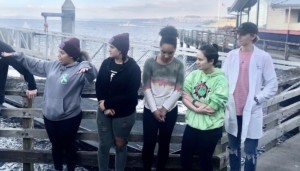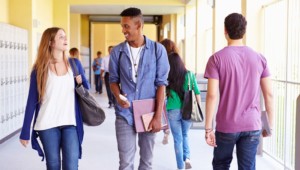Rethinking Urban Education: Tacoma Public Schools of Choice
Key Points
-
Urban schools have the opportunity to pursue meaningful community engagements that can create meaningful new opportunities for students.
-
Learning is at its most impactful when connected to the real world.
-
Strong relationships and trust can be a key factor in supporting a number of unique learning model structures.

Tacoma Public Schools features a network of three specialized high schools providing a wide range of students with an entirely unique high school experience. One that is dedicated to framing the system around the learner while emphasizing trusting relationships, authentic student interest, and the real-world application of learning, while also creating community connections and partnerships to create customizable career pathway opportunities.
The schools are called The School of Industrial Design, Engineering and Art (IDEA), Science and Math Institute (SAMI), and School of the Arts (SOTA), and the three campuses are located in three distinct locations within the city:
- IDEA – A repurposed alternative school that had been vacant and bare for a number of years, which has now been converted into a learning workshop where students engage in engineering, design and entrepreneurial pursuits.
- SAMI – Tucked away inside Point Defiance Zoo (which is itself housed within a state park) sharing space with the zookeepers and providing students with direct access to learn within the walls of the zoo and the trails and water access of the park.
- SOTA – In a number of smaller locations throughout the city’s downtown core and theater district, many of them former art performance or business spaces filled with features like theater seating and dance floors, and connected by downtown sidewalks, streets and light transit.
We recently had a chance to visit these three schools (which today, taken together, comprise the largest high school in the city), and were impressed by the learning, relationships, and spaces we saw.

Interest-Driven Learning
There are a few defining experiences shared by the students at the schools. Juniors at these schools experience programs such as the Next Move Internship Program, with a first semester focused on developing the skills to succeed in the modern workplace, and the second semester is leaving the school for an internship. Students in their junior and senior years can use public transit to split their days between their home campus and one of the other three (students at SOTA regularly take public transit to move between that school’s buildings). The first weeks of January are spent on organized passion projects led by various instructors.
Each school also has its own unique characteristics that differentiate them from one another.
At IDEA, for example, students have contributed to designing a fully functioning (and aesthetically impressive) cafe in a once-depressing ground-floor alcove. Students have designed and built everything from chairs to metal light fixtures with the support of the school’s woodshop teacher (who came to the school through one of their business partnerships after finding a love for teaching) and industrial and interior design teacher, who have developed an innovative “point system” to allow students to design the things they want while still covering the required foundational skills/activities each day.

At SOTA, students take their core classes in what it calls the “Music box,” an area full of collaborative working spaces full of modular furniture housed next door to a theater built in 1918. Many of their art and performance classes take place in spaces that have clearly been recently used by professional artists, with lofted ceilings and soundproofed recording booths and exposed brick walls.
At SAMI, students regularly engage with the natural world to inspire their learning. Lessons and projects take students into the zoo and aquarium, to the Puget Sound to practice fisheries management, and into the state park to experience authentic nature (we saw six deer in the parking lot when we left the school on the day of our visit).

John Kettler, who founded SOTA in 2002, is adamant that use of space is crucial to student learning. If students feel like they’re in a stodgy space that’s owned and held precious by their teacher and/or school, he argues, they are unlikely to approach their learning with creativity and autonomy–and as such are unlikely to build the type of real-world skills the school works to foster.
Kettler also emphasizes that setting up a pipeline to get the right educators is key. When they find that an industry partner has found a passion for education, they work with them to develop a personalized pathway to become an instructor and contribute to the school’s mission and culture. “Schools tend to have lots of managers, when what they need are leaders—people who have a cause, and the permission to pursue it,” says Kettler.
Mentor groups are a really great support system, and like a family outside of home.
Tacoma Public Schools Student
Strong Relationships, Meaningful Trust
At the heart of IDEA, SAMI and SOTA are relationships. These are three schools designed in recognition of the importance of knowing each student and staff member as an individual.
One of the key structures that the schools have developed for ensuring that they are meeting each student’s needs is through mentor groups. Students stay with their same mentor for all four years of their journey, meeting every Wednesday for an extended “community circle” to focus on the schools’ “Four Pillars”: Empathy, Thinking, Community, and Balance. This ensures that each student has a trusted adult that they can turn to at the school, who is also well positioned to provide support and advice aligned to students’ post-secondary goals.
Incoming freshmen are placed into existing mentor groups each year, so they are able to meet older students who can help them navigate the schools’ unique environments and connect them to opportunities like clubs. “They’re a really great support system, and like a family outside of home,” said one of our student tour guides.
When a student stopped Aaron Bellessa, director of SOTA, in the hall to ask him “hey, I’ve been meaning to talk to you about something!”, he responded, “Absolutely–find me later, or send me an email and we’ll set a time!” Their tones were reminiscent of two peers in an office, passing in the hall.
This is all the more impressive when taking into account that the three schools are full inclusion, with many students coming in socially behind peers, and a number of students even coming from different districts.
“Relationships are what change the student experience. It’s all about relationships,” says Kettler.
Closing Thoughts
These three schools are changing what learning looks like, both within and outside of their walls. They are working to support other sites within the district in implementing the Next Move internship program, and continue to develop and strengthen industry and technical partnerships. They continue with their diligent work of giving students access to community assets in order to create customizable career pathway opportunities.
Seeing IDEA, SAMI, and SOTA in person, it is hard not to be hopeful that more and more schools and systems might come to provide similar high school experiences for their students. Experiences rich with exploration, meaningful learning, and personal growth.







0 Comments
Leave a Comment
Your email address will not be published. All fields are required.